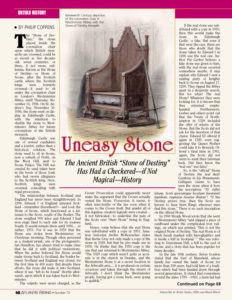
Cutting-edge digital technologies and scientific analysis have revealed more of the story of the Stone of Destiny, the ancient symbol of Scotland’s monarchy which has long held fascination and intrigue due to the mystery of its earliest origins.
Historic Environment Scotland (HES)—who care for the Stone of Destiny on behalf of the Commissioners for the Safeguarding of the Regalia—carried out the work at the Engine Shed, Scotland’s national building conservation center, as preparation of the Stone for the Coronation of King Charles III at Westminster Abbey in May, where it was placed in the Coronation Chair for the ceremony.
A new digital 3D model of the Stone was created, allowing the Stone to be viewed from different perspectives in higher detail than ever before. This revealed previously unrecorded markings on the Stone’s surface, which have the appearance of Roman numerals. The digital imaging also improved visibility of the geological features of the Stone, such as cross-bedding, which is indicative of the geological conditions in which the sandstone was formed and which is characteristic of sandstone of the Scone Sandstone Formation. The many tooling marks evident from original working of the stone and areas of wear and tear can now also be seen more clearly, as well as further details of the 1951 repair.
The digital scanning was also used to create an exact scale 3D printed replica of the Stone, which was used to help prepare for placing the Stone in the Coronation Chair.
Harnessing a wider range of forensic techniques than available in the past, new scientific analysis has also uncovered additional information about the Stone. This has enhanced the results of the previous investigation in 1998, when fragments from the Stone underwent detailed examination by the British Geological Survey. This work identified the Stone as being indistinguishable from sandstones of the Scone Sandstone Formation, which outcrop in the area around Scone Palace, near Perth.
The new examination has provided further evidence for the Stone’s origins, while also unearthing more of its post-quarrying history. X-ray fluorescence (XRF) analysis was undertaken to determine the elemental composition of the Stone, leading to the discovery of traces of copper alloy on the top surface of the Stone that coincide with a dark stain near its centre. This suggests a bronze or brass object has been in contact with or placed on the Stone at some time in its history.
Microscopic traces of gypsum plaster were also found to be present, infilling pores in the sandstone at various places around the Stone, possibly traces of a plaster cast that was taken some time in the past.
The 3D digital model of the Stone of Destiny is available to view at https://sketchfab.com/3d-models/stone-of-destiny-edinburgh-castle-4d46d1df627d41a2adc65f6550b2fa9c.


















